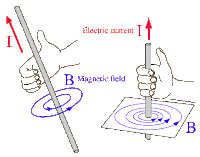Once again, we were assigned to write a ten point blog about what we learned from pg 582-589, this time it's about magnitism. Here goes...
 |
| OMG it's floating with magic!!! (no sorry kids it's just magnetism) |
1. A magnetic field is the first topic among magnetism. It is portrayed as the distribution of a magnetic force in the region of a magnet.
2. Magnets are usually associated with the north and south poles. These two different poles are responsible for magnetic forces. With this knowledge, similars repel and dissimilars attract (similar to many things in life...) So basically, north poles will repel the north pole of another magnet while the same applies for the south poles. North poles will, however, attract (or stick on to) south poles.
3. To measure magnetic forces within an area or object, a device called the test compass is used. It determines the prescence of a magnetic force.
4. There are also metals that exist that are not magnetic, but they can still be attracted by magnets. Examples can include iron, nickel, cobalt, or any mixture of the three. These are known was ferromagnetic metals.
 |
| Explanation of the Domain Theory |
5. In fact, there was even a theory determined for these "ferromagnetic metals". The theory is known as the Domain Theory of Magnets. This theory basically states that all magnets are composed of a large number of smaller and flexible magnets that can interact with each other. These smaller magnets are known as dipoles. When these dipoles within a large magnet line up, a magnetic domain will be produced which will then produce a magnetic charge.
6. Since in the past, magnets could not provide a stable application for permanent use, technology stepped in once again to produce electromagnets. This produces strong and dependable magnets which can also be adjusted strength-wise. Normal magnets would've been impractical in their place because their strength can deteriorate over time and will remain on constantly.
 |
| Shows the motion of Oerstead's discovery. |
7. Many scientists in history tried to determine the common element between electrostatics and magnetism. Among all of these though, Hans Christian Oersted concluded with an important discovery which is now known as Oersted's Principle. It states that the charge moving through a conductor is constantly producing a circular magnetic field around the conductor.
8. Following Oerstead's discoveries, many other scientists developed a number of hand signals for people to predict how specific magnetic forces act. These hand signals are known as Right-hand rules because they all involve your right hand. There is a total of three right-hand rules.
 |
| Diagram explaining how to utilize the first right-hand rule. |
9. The first right-hand rule is used to determine the direction of current flow in a conductor. It is known as the Right-hand rule #1 for conventional current flow (conductors). You have to grasp the conductor with the thumb of your right hand pointing towards the positive current flow. Then, the fingers that are curled indicates the direction of the magnetic field around the conductor.
 |
| Diagram explaining how to utilize the second right-hand rule. |
10. The second right-hand rule is used to determine the direction of current flow within a coiled (stronger than the conductor magnet) electromagnet. It is known as the Right-hand rule #2 for conventional current flow (coils). You grasp the coiled conductor with your right hand so the thumb points at the direction of the magnetic field or positive end (thumb respresents the north end of the electromagnet). Once again, the curled fingers will represent the direction the current is flowing.
This concludes my third set of 10 points I have learned. Thank you for reading!! :)
No comments:
Post a Comment